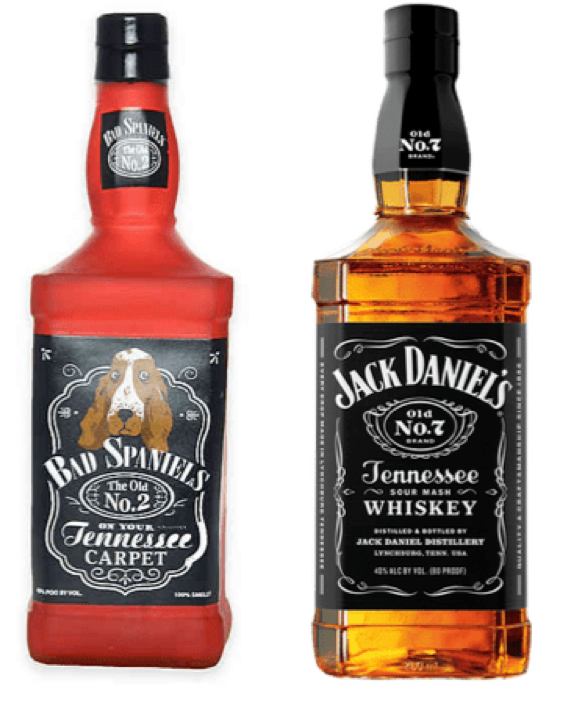“There are two critical limitations to using a likelihood of confusion standard in dilution matters. First, when the allegedly diluting product is ‘light-hearted’ in nature, some courts have ignored survey evidence in favor of protections of expression under the Rogers test. Second, courts have delineated that trademark dilution can exist independent of confusion.”
 In March 2023, the Supreme Court reviewed a dispute over whether VIP Products’ “Bad Spaniels Silly Squeaker” chew toy for dogs infringes upon Jack Daniel’s trademark rights. Throughout a nine-year legal disagreement, Jack Daniel’s has held that VIP Products’ dog toy infringes and dilutes its trademark and trade dress, particularly for its “Old No. 7 Brand Tennessee Sour Mash Whiskey.” VIP Products, on the other hand, has maintained its stance that the use of its “Bad Spaniels” name and mark “does not infringe or dilute any claimed trademark rights,” and that the at-issue dog toy bears design elements that “make it clear that the product is a parody.”
In March 2023, the Supreme Court reviewed a dispute over whether VIP Products’ “Bad Spaniels Silly Squeaker” chew toy for dogs infringes upon Jack Daniel’s trademark rights. Throughout a nine-year legal disagreement, Jack Daniel’s has held that VIP Products’ dog toy infringes and dilutes its trademark and trade dress, particularly for its “Old No. 7 Brand Tennessee Sour Mash Whiskey.” VIP Products, on the other hand, has maintained its stance that the use of its “Bad Spaniels” name and mark “does not infringe or dilute any claimed trademark rights,” and that the at-issue dog toy bears design elements that “make it clear that the product is a parody.”
In trademark matters, consumer surveys are routinely admitted as evidence that informs marketplace outcomes, from dilution, to confusion, to distinctiveness. Factual issues that survey evidence may inform include whether a mark is generic, contains secondary meaning, is likely to cause confusion in the marketplace, or is diluted by or dilutes another mark.
The VIP Products v. Jack Daniel’s case raises questions about the appropriate and relevant empirical evidence that may aid the trier of fact in analyzing key issues, including likelihood of confusion, humor, and tarnishment. Below we consider these questions, which may be relevant in future matters of this kind.
History and Motivating Case Examples
Trademark dilution cases have a long history. While protections from trademark dilution were not codified at the federal level until 1996, many state laws had already established such protections decades earlier. Many of these matters revolved around famous marks that companies had created and then invested tens – if not hundreds – of millions of dollars to build up a set of associations that produced and promoted brand equity. Federal and state protections from trademark dilution sought to shield existing brands from potential marketplace disruptions, including the entrance of a new product that may evoke and poke fun at an existing brand, and hence may constitute a threat to those associations.
Some companies who put out products that humorously lean on the name and recognition of an original mark do so in a way that does not influence the perception and value of the latter. According to courts, these companies should be allowed to offer their fun-evoking marks to consumers. In that context, a mark’s ability to successfully parody another mark hinges – per the Fourth Circuit – on the delivery of two contradictory messages: “that it is the original, but also that it is not the original and is instead a parody.”
However, even a successful parody can tarnish the parodied brand. The Federal Trademark Dilution Act prohibits what it calls “dilution by tarnishment,” which it defines as an “association arising from the similarity between a mark or trade name and a famous mark that harms the reputation of the famous mark.” Trademark dilution can occur “regardless of the presence or absence of actual or likely confusion, of competition, or of actual economic injury.”
Relevant Empirical Methods to Assess Trademark Dilution
Empirical evidence can help the trier of fact make inferences about consumers’ perceptions and behavior in the real world. In the currently reviewed Jack Daniel’s case, as well as in other trademark dilution matters, empirical research can illuminate the following three issues:
- Likelihood of Confusion. Does the at-issue dog toy evoke the Jack Daniel’s brand as a source or affiliate? If consumers do not distinguish between the dog toy and the Jack Daniel’s brand, Jack Daniel’s may be injured.
- Humor. Is the at-issue dog toy a humorous evocation of the Jack Daniel’s brand? If consumers recognize VIP Products’ dog toy as a comedic evocation of the Jack Daniel’s brand and do not confuse the two brands, Jack Daniel’s may not be injured.
- Tarnishment. Is the at-issue dog toy’s evocation of the Jack Daniel’s brand harmful to Jack Daniel’s? Even if consumers understand the dog toy to be a parody of Jack Daniel’s, they may still be left with a negative association with the Jack Daniel’s brand, resulting in potential injury to Jack Daniel’s.
1. Likelihood of Confusion Surveys
Likelihood of confusion studies have been used in several trademark dilution matters, including the Jack Daniel’s case. Jack Daniel’s’ expert, Gerald Ford, introduced evidence from an Eveready study finding a net confusion rate of 28.9%, and used this evidence to support the argument that “potential purchasers of a dog toy are likely to be confused or deceived by the belief that Plaintiff’s Bad Spaniels dog toy is made or put out by Jack Daniel’s … and that such confusion is due in particular to Plaintiff’s use of Jack Daniel’s indicia or trade dress on the Bad Spaniels dog toy.”
In Starbucks v. Lundberg, a trademark dilution case involving an Oregon-owned coffeehouse named “Sambuck’s Coffeehouse,” the court noted that survey evidence of confusion put forth by the defendant’s expert provided “direct evidence that…the name ‘Sambuck’s’ creates a likelihood of both … dilution [by tarnishment and blurring].” Similarly, in another trademark dilution case, Jada Toys, Inc. v. Mattel, Inc., the court stated that, “a reasonable trier of fact could conclude that [the survey] evidence was sufficient to establish the existence of actual dilution.”
These examples illustrate that measurements of confusion may be relevant to evaluating the likelihood of dilution. Commonplace tools to measure likelihood of confusion include Eveready– and Squirt-format surveys. In typical applications of the Eveready format, respondents are shown the allegedly infringing mark/dress and asked who or what company makes or puts out the goods or services depicted in the stimuli they were shown. In typical applications of the Squirt format, respondents are shown the allegedly infringing mark/dress beside several other marks, including the product or service that is allegedly infringed, and asked to what extent the at-issue product is similar to each product in the array. In conjunction with scientific research standards for litigation, such as employing an experimental design to draw causal inferences and net out noise, these surveys can provide reliable estimates for likelihood of confusion in the marketplace.
There are two critical limitations to using a likelihood of confusion standard in dilution matters. First, when the allegedly diluting product is “light-hearted” in nature, some courts have ignored survey evidence in favor of protections of expression under the Rogers test. Second, courts have delineated that trademark dilution can exist independent of confusion, thus relegating the importance of the likelihood of confusion standard in certain cases.
Given these limitations, we consider two additional empirical methods relevant to dilution matters. These surveys study whether consumers (1) perceive humor in the alleged infringing product, and (2) internalize a new or negative association with the original mark. Barking up these trees may provide relevant evidence to assess parody and tarnishment in the marketplace.
2. Humor Surveys
As survey scholar Thomas McCarthy notes, “the cry of ‘parody!’ does not magically fend off otherwise legitimate claims of trademark infringement or dilution. There are confusing parodies and non-confusing parodies. All they have in common is an attempt at humor through the use of someone else’s trademark. A non-infringing parody is merely amusing, not confusing.” But could the cry of parody alongside consumer survey evidence of humor carry more weight than the cry alone? Perhaps. A Trademark Reporter article astutely asks, “If the commentary in the form of humor or criticism is recognized and obvious […], why would consumers be confused?” Harvard Law professor Rebecca Tushnet noted in a New York Times article covering the Jack Daniel’s case that “humor should count in the chew toy case now before the justices.” Below we consider methods by which parties could assess consumers’ perception of amusement, entertainment, or humor regarding a parodist’s product.
Existing marketing literature suggests that questions using Likert-type scale constructs are one method to test consumers’ perception of humor. In some studies, for example, researchers have shown survey respondents stimuli hypothesized to be humorous (e.g., a humorous ad) and asked respondents to complete the following exercise via a Likert scale construct: “The [stimulus] that I just saw was: Humorous/Not humorous, Funny/Not funny, Amusing/Not amusing.” Analysis of these results provided researchers with a measure of consumers’ perception of humor. Extensions of these studies could include assessing the source of the humor (i.e., is the dog toy funny because it evokes the Jack Daniel’s brand in an unusual context, or is it funny simply because it references scatological humor?)
Similar question constructs could provide useful evidence to the court for assessing consumers’ marketplace perceptions in trademark dilution matters. This type of survey evidence may even take the burden off of the judge, or other trier of fact, to determine whether the parodist’s humorous intent landed in the minds of consumers.
3. Tarnishment Surveys
Another potentially useful form of survey evidence includes surveys that attempt to measure reputational harm to the famous mark. From prior matters, we know that courts have ruled in favor of defendants who have claimed that sex associations were tarnishing their brands, and it is not unreasonable to expect there could also be tarnishment from bathroom humor, as is this Jack Daniel’s case.
Specifically, consumer surveys could illuminate whether a new user’s spoof of a mark leads consumers to change their underlying brand associations with the famous mark. A few methods are worth considering.
First, researchers and expert witnesses Suneal Bedi and David Reibstein offer an empirical approach for measuring tarnishment in their 2020 article “Measuring Trademark Dilution by Tarnishment.” Bedi and Reibstein argue that “[a]t its core, trademark dilution is an empirical cause of action.” As such, “Clear empirical proof of harm using experimental methodology is the only way to prove if there is a likelihood of trademark dilution.”
In their proposed methodology, Bedi and Reibstein suggest an experimental study that exposes respondents to the allegedly tarnishing product or a properly designed control product and poses brand perception questions about the original mark. By comparing responses between treatment and control groups, any impact on the original mark from the allegedly tarnishing product can be measured.
A second method to test the effect, if any, of an at-issue mark on consumers’ associations with the original brand may be adapted from “The Science of Proving Trademark Dilution,” an article by Barton Beebe, Roy Germano, Christopher Jon Sprigman, and Joel Steckel. Similar to the Bedi and Reibstein methodology, the authors propose an experimental approach that subjects respondents to either an at-issue advertisement or an appropriately designed control and then shows respondents a series of brand-word pairs. Again, by comparing positive and negative associations between treatment and control groups, any impact of the at-issue advertisement on the original brand can be measured.
Taking the Jack Daniel’s case as an example, these methods could be adapted to present respondents with the VIP Products’ at-issue dog toy or a modified control to assess (1) the extent to which Jack Daniel’s core brand associations remain after exposure to the allegedly infringing dog toy, and (2) the extent to which consumers develop new brand associations, such as disgust or bathroom-related themes, after exposure to the infringing dog toy.
Regardless of how the Supreme Court rules in the present case, these methods are likely to be of continuing use to IP litigators and experts in similar matters to come.

![[IPWatchdog Logo]](https://ipwatchdog.com/wp-content/themes/IPWatchdog%20-%202023/assets/images/temp/logo-small@2x.png)




![[Advertisement]](https://ipwatchdog.com/wp-content/uploads/2024/04/Patent-Litigation-Masters-2024-sidebar-early-bird-ends-Apr-21-last-chance-700x500-1.jpg)

![[Advertisement]](https://ipwatchdog.com/wp-content/uploads/2021/12/WEBINAR-336-x-280-px.png)
![[Advertisement]](https://ipwatchdog.com/wp-content/uploads/2021/12/2021-Patent-Practice-on-Demand-recorded-Feb-2021-336-x-280.jpg)
![[Advertisement]](https://ipwatchdog.com/wp-content/uploads/2021/12/Ad-4-The-Invent-Patent-System™.png)







Join the Discussion
One comment so far.
Anon
May 22, 2023 11:53 amWithout going to the merits of the article (and let’s face it, the “triers of fact won’t bother either), I would posit that the Warhol case bodes ill for the doggie-toy folks here.